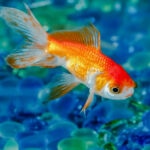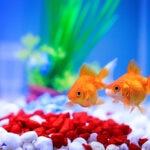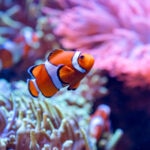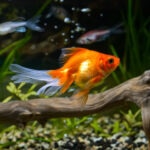Create a Lake Tanganyika Biotope Aquarium
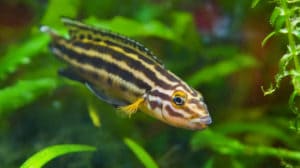
Photo by Chewy
Our fish farm in South Florida uses hundreds of 300- to 6,000-gallon outside vaults (large above-ground concrete structures) on 5 acres of land to breed and raise thousands of African cichlids for sale to retail shops all over the United States and in Canada. Many fishkeepers purchase our fish, but how should they house these African cichlids?
If you’re keeping Tanganyikan fish, a great way is to try to replicate the environmental conditions of Lake Tanganyika in Africa. Lake Tanganyika is the sixth largest lake in the world by surface area, covering about 12,700 square miles, and it is the third largest by volume (4,500 cubic miles). It is home to about 400 species of fish (some 250 of those being cichlids). The lake’s water chemistry ranges from 7.5 to 9.3 pH, and it has a total hardness of 10 to 12 degrees and a year-round temperature of 76 to 78 degrees Fahrenheit. With depths of up to 4,700 feet, Lake Tanganyika is the second deepest lake in the world. It is mostly surrounded by mountains, except for a small portion on the east side, and it offers both rocky and sandy coastlines.
With all of these conditions, it’s no wonder that there are so many varieties of cichlids that have found their own little niches and continue to thrive in Lake Tanganyika. Keeping those conditions in mind and mimicking them on a smaller scale is how we are able to enjoy these beautiful creatures in our homes. To create a Lake Tanganyika biotope, you’ll need to get your tank supplies, set up the tank, wait for it to cycle, add fish and maintain it properly. Begin by obtaining all of the supplies you’ll need to set up a Lake Tanganyikan aquarium.
Aquarium Supplies
Aquarium
A 50-gallon long tank is a good middle-of-the-road tank. You can start with something smaller, but most people will soon wish they had gotten a larger tank. Substrate. Base sand as substrate can be found in various degrees of coarseness. Keep in mind that larger grains of sand will give more of a textured look and are less likely to be sucked up into the tube when you vacuum the substrate during water changes. Also, while many different colors of sand can be found in stores, natural-looking tan-colored sand provides a more authentic look to what is found in Lake Tanganyika.
Rocks
There are a lot of rocks to choose from. Rocks are heavy and take up a lot of room, so the local shop may carry only a couple of choices. The fish won’t care what the rock looks like, but they will appreciate little hiding places to call their own, retreats when a threat is perceived. So when shopping for rock, keep in mind that the aesthetics of the rock formation are for your eyes only, and choose something that makes you feel good when you look at it. Be aware that not all rocks may be safe for your fish. If you’ve found a rock on the beach or out in the yard, run it by someone at the local fish store (LFS) before introducing it into your tank. Also make sure that collecting rocks in that area is legal before taking any.
Round river rock comes in various shades of brown or gray, and in varying sizes (think softball to baseball to golf ball sizes). Mix river rocks with flat rocks to form tunnels and caves to create a peaceful, authentic look similar to the floor of their natural home in Africa.
Honeycomb (holey) limestone rock is showing up in more shops and has more than just good looks to bring to the cichlid tank: It creates plenty of hiding places and leaches beneficial minerals into the water. Cichlids like their water on the hard side, and calcium, magnesium and carbonate leach into the water from limestone, which contributes to water hardness. This won’t be enough if your water is soft, so you may need an additive to harden your water even further.
There is other rock available, of course, even manmade rocks that can be rearranged easily. An added benefit of interchangeable rock formations will become evident when it’s time to add a new fish to an established tank. The existing fish will be quite territorial over the area of rock they’ve claimed, so rearrange the rocks when adding a new fish. The old fish will be busy seeking out a new territory, and they won’t pay much attention to the newcomers, giving them time to assimilate into the group.
Filter
You will never regret the money spent on a good fish tank filter – so take a little time deciding which kind you want, and get the best you can afford that suits your needs. There are a lot of different fish filter types available, but hanging filters and canister filters are the most common styles. They will both siphon water out, run it through filtration media and return it to the tank. Neither filtering system is challenging to maintain; it will just come down to personal preference and cost. (See the “Filter Maintenance” sidebar for more information.)
Lights
Lighting for a cichlid tank is mostly for the outside viewer. The fish don’t require a particularly high amount of light, but it can sure make them prettier to look at. With no plants in the tank, there’s no need for any kind of grow light; a good-quality fluorescent light will do just fine. Some light fixtures rest on top of the tank (a top is necessary if any of your fish are jumpers), and others are elevated a few inches above the top of the tank.
Heater
Remember that your cichlids are from a place where the water stays at about 76 to 78 degrees Fahrenheit year-round, so you’ll need to offer that consistency in the tank as well. Also, while most heaters have a gauge showing target temperature, it is a good idea to verify the accuracy by using a thermometer.
Miscellaneous
Various water treatments, food and incidental items will be recommended by your LFS, depending on your water conditions, how soon you want to add your first fish and how many conveniences you want to invest in. Also consider adding a fault-protected power strip to the setup for obvious safety reasons.
Setting up the Tank
Once you’ve acquired all that you need, it’s time to assemble and add the water.
- First, choose a spot to set up the aquarium. A good spot has access to electricity, isn’t too far from a water source, isn’t too close to windows (which can cause algae) and is close to seating for easy viewing. Make sure the tank is level before adding decor or water.
- Pour in the sand substrate to a depth of 2 to 3 inches. Get a little creative, maybe creating a higher dune off to one side, but don’t obsess over it; your fish will probably spend a good deal of time rearranging the lay of the land once they claim their territories.
- Spend some time placing and arranging the rocks so that they look good to you. If you’ve chosen river rocks, arrange them in groups of odd numbers to make them look their best. You can always rearrange your current rocks or add more rocks later.
- Place the filter and heater, and block the view of them with rock where possible. Place the heater in the water current from the filter output to aid in equalizing the water temperature.
- Before adding the water, place a plate on the substrate; this will keep the water from disturbing the substrate any more than necessary. Use a bucket or a hose attached to a faucet, and gently pour the water directly onto the plate.
- Put the light fixture in place, then plug everything in and turn everything on. Let everything run to let the sand and sediment settle, to let the temperature adjust and let the filter season.
- Wait to add fish until beneficial bacteria has built up and the nitrogen cycle has completed. The nitrogen cycle can take several weeks to complete. Most local fish stores will perform basic water tests for free and can tell you when it’s safe to add fish. Just take in a small sample from your tank – they’ll run the tests and make recommendations if needed.
Choosing Fish
After the nitrogen cycle has established, it’s time to purchase fish. Before you even purchase your tank and equipment, have an idea of what fish you want to include in the setup. While researching which fish to purchase, note the cichlids that appeal to you. Some are more aggressive and territorial than others, so ask for advice and read books and magazines about which fish will be compatible and do well in your setup.
Most hobbyists want a variety of fish that will inhabit the tank at different depths and in different areas of the tank. Because different species have different water-level preferences, the availability of caves or nooks at those different heights will provide the homes for a specific fish at its comfort level. The fish that prefer to live at the bottom of the water column might look for an empty shell or small overturned clay pot away from other fish, while the mid- to upper-level fish might use nooks or caves. Some fish prefer an open expanse of sand where they will spend a good deal of time creating a dug-out circle to defend and call their own for breeding purposes. There are hundreds of species to choose from, including Julidochromis Marlieri (Spotted Julie), Cyphotilapia frontosa and Cyprichromis leptosoma. As your knowledge and skills grow, it will be fun to seek out other varieties and slowly add them.
Compatibility and Stocking
A good mix of fish with varying territory preferences will assure something interesting is always going on wherever you look. While it’s true that the male is typically the more colorful and interesting of the African cichlids, he won’t be nearly as colorful or interesting if there are no females to show off for. For the safety of the female, there should be two females for each male – this alleviates aggressive behavior when a chosen female isn’t interested in amorous overtures.
How Many Lake Tanganyikan Fish to Start With
Next determine how many fish your tank will accommodate – and several factors come into play here. A basic rule for freshwater aquariums is to provide 1 gallon of water for 1 inch of fish. Also keep in mind that while your tank may hold 55 gallons, the substrate, rock and other decorations will displace some water. It’s fairly common to start off with far fewer than the maximum number of fish a tank will accommodate. More attention will be paid to which species you choose initially and how many of each there should be. Your fish will perceive safety in numbers, so purchase six of each type of fish you like. This is a good starting place so that your fish can feel secure and so that you can observe their interactions with each other.
Feeding Tanganyikan Cichlids
Most cichlids available at local fish shops are bred and raised in captivity and have been conditioned to eat dry foods formulated for their nutritional needs. Krill, herring, fish and shrimp (protein) and Spirulina (plant matter) should be prominently listed as ingredients. Cichlids can be carnivorous (preying on other fish and their fry), herbivorous (eating algae scraped from rocks) or omnivorous (eating plant matter, as well as invertebrates and smaller fish). Even though a fish may be categorized as carnivorous or herbivorous, it still benefits from a little of “the other food.”
What about sinking pellets or flakes? Some aquarists think of flakes as being the only fish food, but most cichlid farmers rely on sinking pellets to grow out their stock. If your fish respond to one better than the other, it’s probably not critical which one you choose. However, if catfish or other bottom-feeders share the tank, they stand a better chance of getting to the food if it makes it to the bottom.
Cichlids are ravenous eaters, and they won’t stop until all the food is gone. Since feeding shouldn’t be longer than about 30 seconds, this doesn’t give the viewer much time to enjoy the event. Every now and then, try offering your cichlids a leaf of romaine lettuce attached to the glass with a magnetic clip, find a comfortable chair, and sit and enjoy watching them snatching bites. If there is any leftover lettuce, remove it after 30 minutes to avoid fouling the water.
Books, magazines, online forums and your LFS can help you learn how to best acclimate fish and how to feed them, as well as basic care instructions. After you’ve set up the tank, do your weekly water changes, feed your cichlids once or twice a day, and enjoy your Lake Tanganyikan setup!
Rick and Tamela Biro are co-owners of two businesses located in South Florida: Florida Exotic Fish Sales and Xtreme Aquatic Foods, Inc. Rick’s love of cichlids began while he studied at Florida State University. His life’s work is breeding and selling African cichlids all over the United States, and over the years, Rick worked to develop a well-known cichlid diet.
Featured Image: Aleron Val/Shutterstock
